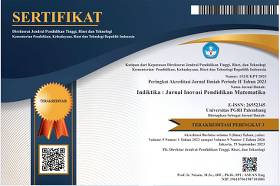Persepsi Etnomatematika dalam Pembelajaran Matematika
DOI:
https://doi.org/10.31851/indiktika.v7i1.16993Keywords:
etnomatematika, persepsi, kontekstualAbstract
Kajian ini bertujuan untuk membahas mengenai persepsi guru dan siswa mengenai etnomatematika. Penelitian etnomatematika di Indonesia telah menghasilkan dua pendekatan yang saling melengkapi, yaitu sebagai alat bantu pembelajaran dan sebagai kerangka kerja penelitian. Pendekatan pembelajaran etnomatematika bertujuan untuk memperkaya pemahaman siswa akan konsep-konsep matematis melalui integrasi dengan unsur-unsur budaya lokal, sementara pendekatan penelitian etnomatematika berupaya mengungkap dan mendeskripsikan manifestasi konsep-konsep matematis dalam berbagai praktik budaya. Studi-studi etnomatematika seringkali mengungkap adanya penggunaan konsep matematis yang implisit dalam aktivitas sehari-hari masyarakat, sehingga berkontribusi pada pemahaman yang lebih komprehensif tentang bagaimana pengetahuan matematis dibangun dan diwariskan secara lintas generasi dalam suatu budaya. Penelitian ini menggunakan pendekatan deskriptif kualitatif untuk mendeskripsikan implementasi konsep etnomatematika pada guru dan siswa SMP di Kota Merauke. Melalui analisis data yang diperoleh dari kajian pustaka, angket, dan wawancara mendalam, penelitian ini menyimpulkan bahwa potensi pengembangan etnomatematika di wilayah tersebut masih terbuka lebar. Namun demikian, kajian lebih lanjut masih diperlukan untuk menggali potensi dan tantangan dalam pengembangan pendekatan pembelajaran yang lebih kontekstual.
References
Abi, A. M. (2017). Integrasi Etnomatematika dalam Kurikulum Matematika Sekolah. JPMI (Jurnal Pendidikan Matematika Indonesia), 1(1), 1–6.
Achor, E. E., Imoko, B., & Uloko, E. (2009). Effect of Ethnomathematics Teaching Approach on Senior Secondary Students’ Achievement and Retention in Locus. Educational Research and Review, 4(8), 385–390.
Arisetyawan, A. (2015). Etnomatematika Masyarakat Baduy. Universitas Pendidikan Indonesia.
Barton, B. (2007). Making Sense of Ethnomathematics: Ethnomathematics is making sense. In Stepping stones for the 21st century (pp. 225–255). Brill.
Bishop, A. J. (1994). Cultural Conflicts in Mathematics Education: Developing a Research Agenda. For the Learning of Mathematics, 14(2), 15–18.
d’Ambrosio, U. (1977). Science and Technology in Latin America during its Discovery. Impact of Science on Society, 27, 267–274.
d’Ambrosio, U. (1985). Ethnomathematics and its Place in the History and Pedagogy of Mathematics. For the Learning of Mathematics, 5, 44–48.
d’Ambrosio, U. (1990). The Role of Mathematics Education In Building A Democratic And Just Society. For the Learning of Mathematics, 10(3), 20–23.
d’Ambrosio, U. (2001). In My Opinion: What Is Ethnomathematics, and How Can It Help Children in Schools? Teaching Children Mathematics, 7(6), 308–310.
Fitriza, R. (2018). Ethnomathematics pada ornamen rumah gadang minangkabau. Math Educa Journal, 2(2).
Gerdes, P. (2011). African Basketry: Interweaving Art and Mathematics in Mozambique. Proceedings of Bridges 2011: Mathematics, Music, Art, Architecture, Culture, 9–16.
Hartoyo, A. (2013). Etnomatematika pada Budaya Masyarakat Dayak Perbatasan Indonesia-Malaysia. Jurnal Pendidikan Matematika Dan IPA, 2(1), 29–39.
Haryanto, D. N., Nusantara, T., & Subanji, S. R. (2017). Etnomatematika Arfak (Papua Barat-Indonesia): Operasi Bilangan pada Perniagaan Masyarakat Arfak Masa Lalu. Prosiding SI MaNIs (Seminar Nasional Integrasi Matematika Dan Nilai Islami), 288–292.
Haryanto, T. N. (2015). Subanji,“Etnomatematika pada Noken Masyarakat Papua,.” Seminar Nasional Matematika Dan Pendidikan Matematika UNY, 1177–1184.
Horsthemke, K., & Schafer, M. (2007). Does’ African mathematics’ Facilitate Access to Mathematics? Towards an ongoing critical analysis of ethnomathematics in a South African context. Pythagoras, 2007(65), 2–9.
Marchis, I. (2009). Symmetry and Interculturality. Acta Didactica Napocensia, 2(1), 57–62.
Matang, R. A. (2005). Formalising the Role of Indigenous Counting Systems in Teaching the Formal English Arithmetic Strategies through Local Vernaculars: An example from Papua New Guinea. 28th Conference of Mathematics Education Research Group of Australasia, Melbourne, 505–512.
Matang, R. A. S., & Owens, K. (2014). The Role of Indigenous Traditional Counting Systems in Children’s Development of Numerical Cognition: Results from a study in Papua New Guinea. Mathematics Education Research Journal, 26, 531–553.
Moleong, L. J. (2019). Metodologi Penelitian Kualitatif (Revisi). PT Remaja Rosdakarya.
Mosimege, M. (2017). Listening to the Voices of the Knowledge Holders: The Role of Language in Ethnomathematical Research. Ethnomathematics and Its Diverse Approaches for Mathematics Education, 51–67.
Orey, D., & Rosa, M. (2007). Cultural Assertions and Challenges Towards Pedagogical Action of an Ethnomathematics Program. For the Learning of Mathematics, 27(1), 10–16.
Prahmana, R. C. I., Yunianto, W., Rosa, M., & Orey, D. C. (2021). Ethnomathematics:"Pranatamangsa" System and the Birth-Death Ceremonial in Yogyakarta. Journal on Mathematics Education, 12(1), 93–112.
Sugiyono. (2019). Metode Penelitian Kuantitatif, Kualitatif, dan R&D. Alfabeta.
Turmudi, T. (2017). Ethnomathematics: Apa Mengapa dan Bagaimana Implementasi dalam Pembelajaran Matematika di Kelas. SENATIK 2017.
Weldeana, H. N. (2015). Gender Positions and High School Students’attainment in Local Geometry. International Journal of Science and Mathematics Education, 13, 1331–1354.
Zhang, W., & Zhang, Q. (2023). Ethnomathematics and its Integration within the Mathematics Curriculum. Journal of Mathematics Education, 151–157.
Downloads
Published
Issue
Section
License
Copyright (c) 2024 Inggrid Marlissa, Dadang Juandi, Turmudi Turmudi

This work is licensed under a Creative Commons Attribution-ShareAlike 4.0 International License.
This work is licensed under a Creative Commons Attribution-ShareAlike 4.0 International License.
Authors who publish with this journal agree to the following terms:
- Authors retain copyright and grant the journal right of first publication with the work simultaneously licensed under a Creative Commons Attribution License that allows others to share the work with an acknowledgement of the work's authorship and initial publication in this journal.
- Authors are able to enter into separate, additional contractual arrangements for the non-exclusive distribution of the journal's published version of the work (e.g., post it to an institutional repository or publish it in a book), with an acknowledgement of its initial publication in this journal.
- Authors are permitted and encouraged to post their work online (e.g., in institutional repositories or on their website) prior to and during the submission process, as it can lead to productive exchanges, as well as earlier and greater citation of published work.












